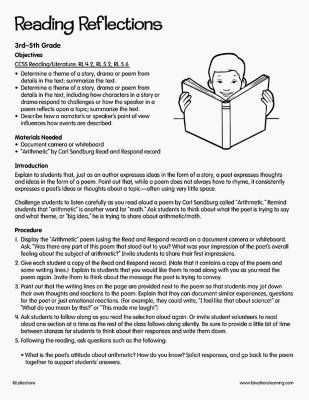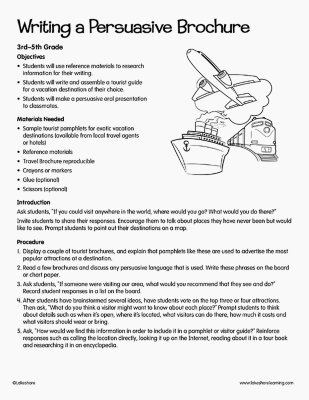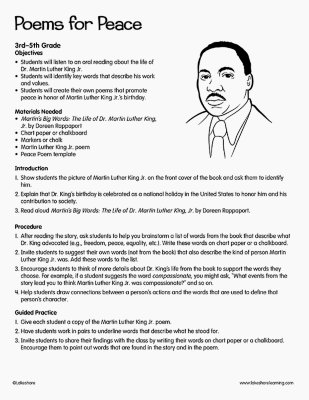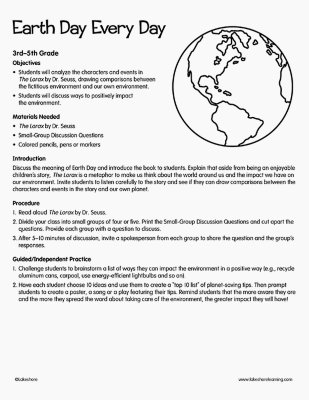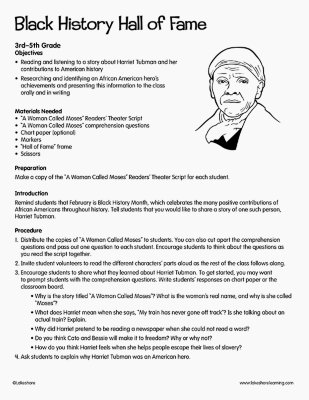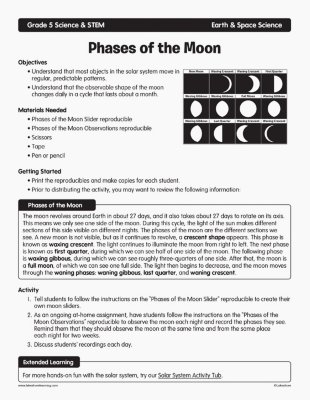Narrow by Grade
- Infant (0)
- Toddler (0)
- Preschool (0)
- Pre-K (0)
- Kindergarten (0)
- 1st (0)
- 2nd (0)
- 3rd (3)
- 4th (3)
- 5th (6)
- 6th & Up (0)
Grade
Narrow by Age
- 0-18m (0)
- 18-36m (3)
- 3 yrs. (0)
- 4 yrs. (12)
- 5 yrs. (18)
- 6 yrs. (20)
- 7 yrs. (14)
- 8 yrs. (19)
- 9 yrs. (20)
- 10 yrs. (6)
- 11 yrs. & Up (0)
Age 10 yrs.
6 results for "nuts about"
Filters
Clear All
Reading Reflections
5th Grade
Objectives CCSS Reading/Literature: RL.4.2, RL.5.2, RL.5.6 Determine a theme of a story, drama or poem from details in the text; summarize the text. Determine a theme of a story, drama or poem from details in the text, including how characters in a story or drama respond to challenges or how the speaker in a poem reflects upon a topic; summarize the text. Describe how a narrator’s or speaker’s point of view influences how events are described. Materials Needed Document camera or whiteboard “Arithmetic” by Carl Sandburg Read and Respond record Introduction Explain to students that, just as an author expresses ideas in the form of a story, a poet expresses thoughts and ideas in the form of a poem. Point out that, while a poem does not always have to rhyme, it consistently expresses a poet’s ideas or thoughts about a topic—often using very little space. Challenge students to listen carefully as you read aloud a poem by Carl Sandburg called “Arithmetic.” Remind students that “arithmetic” is another word for “math.” Ask students to think about what the poet is trying to say and what theme, or “big idea,” he is trying to share about arithmetic/math.
View Lesson PlanWriting a Persuasive Brochure
3rd Grade - 5th Grade
Objectives Using reference materials to research for their writing Introducing the topic or text they are writing about, stating an opinion and creating an organizational structure that lists reasons Providing reasons that support the opinion Reporting on a topic or text, telling a story, or recounting an experience in an organized manner, using appropriate facts and relevant, descriptive details to support main ideas or themes; speaking clearly at an understandable pace Materials Needed Sample tourist pamphlets for exotic vacation destinations (available from local travel agents or hotels) Reference materials Travel Brochure reproducible Crayons or markers Glue (optional) Scissors (optional) Introduction Ask students, “If you could visit anywhere in the world, where would you go? What would you do there?” Invite students to share their responses. Encourage them to talk about places they have never been but would like to see. Prompt students to point out their destinations on a map.
View Lesson PlanPoems for Peace
5th Grade
Objectives Students will listen to an oral reading about the life of Dr. Martin Luther King Jr. Students will identify key words that describe his work and values. Students will create their own poems that promote peace in honor of Martin Luther King Jr.’s birthday. Materials Needed Martin’s Big Words: The Life of Dr. Martin Luther King, Jr. by Doreen Rappaport Chart paper or chalkboard Markers or chalk Martin Luther King Jr. poem Peace Poem template Introduction Show students the picture of Martin Luther King Jr. on the front cover of the book and ask them to identify him. Explain that Dr. King’s birthday is celebrated as a national holiday in the United States to honor him and his contribution to society. Read aloud Martin’s Big Words: The Life of Dr. Martin Luther King, Jr. by Doreen Rappaport.
View Lesson PlanEarth Day Every Day
3rd Grade - 5th Grade
Objectives Students will analyze the characters and events in The Lorax by Dr. Seuss, drawing comparisons between the fictitious environment and our own environment. Students will discuss ways to positively impact the environment. Materials Needed The Lorax by Dr. Seuss Small-Group Discussion Questions Colored pencils, pens or markers Introduction Discuss the meaning of Earth Day, and introduce the book to students. Explain that aside from being an enjoyable children’s story, The Lorax is a metaphor to make us think about the world around us and the impact we have on our environment. Invite students to listen carefully to the story and see if they can draw comparisons between the characters and events in the story and our own planet.
View Lesson PlanBlack History Hall of Fame
3rd Grade - 5th Grade
Objectives Reading and listening to a story about Harriet Tubman and her contributions to American history Researching and identifying an African American hero’s achievements and presenting this information to the class orally and in writing Materials Needed “A Woman Called Moses” Readers’ Theater Script “A Woman Called Moses” comprehension questions Chart paper (optional) Markers “Hall of Fame” frame Scissors Preparation Make a copy of the “A Woman Called Moses” Readers’ Theater Script for each student. Introduction Remind students that February is Black History Month, which celebrates the many positive contributions of African Americans throughout history. Tell students that you would like to share a story of one such person, Harriet Tubman.
View Lesson PlanPhases of the Moon
5th Grade
Objectives
- Understand that most objects in the solar system move in regular, predictable patterns.
- Understand that the observable shape of the moon changes daily in a cycle that lasts about a month.
